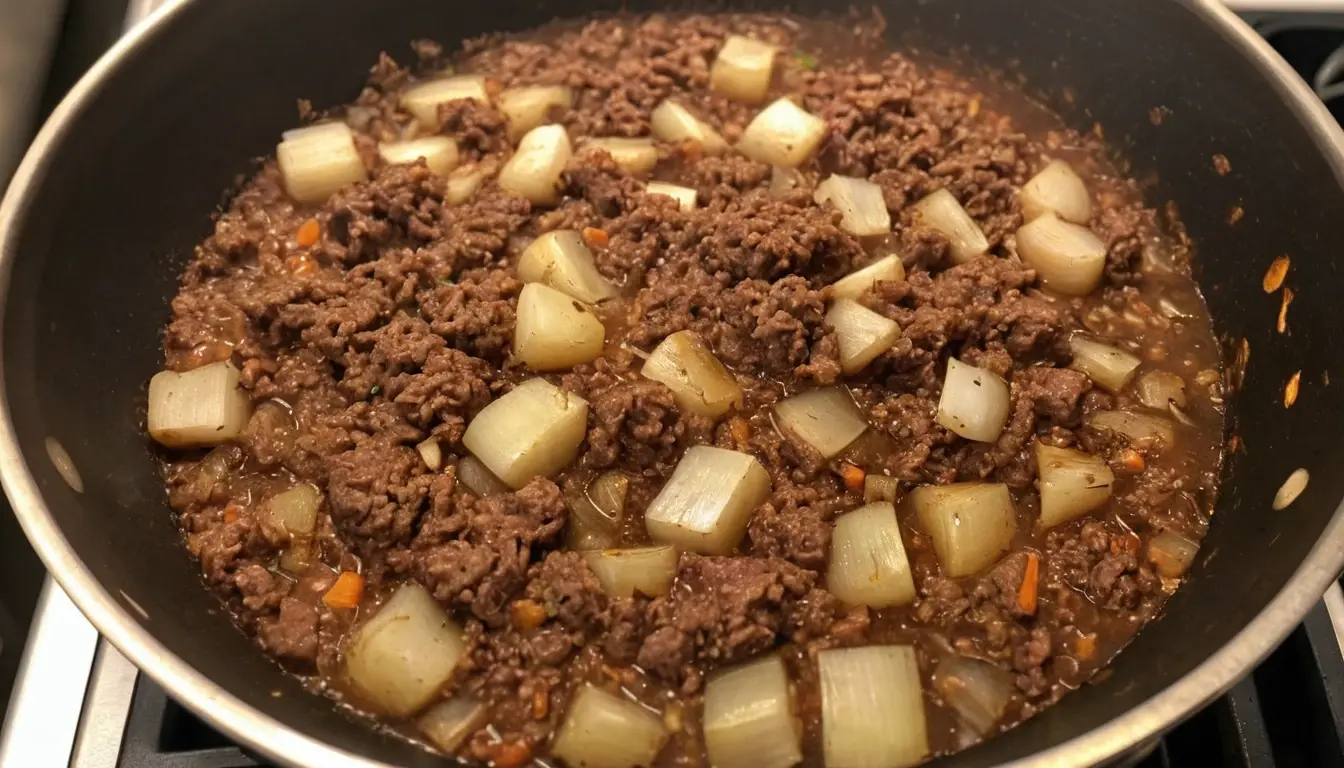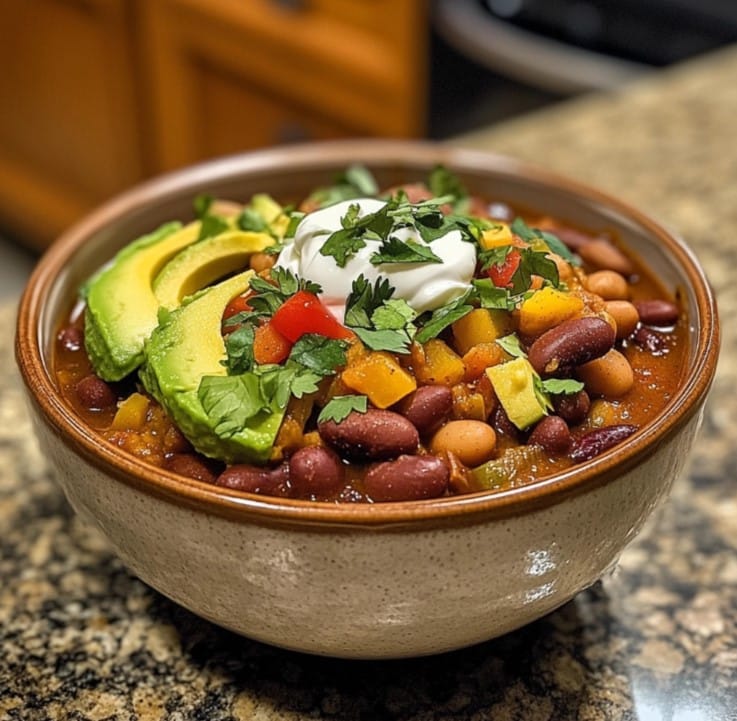There’s something truly magical about a bowl of Perfect Chili. It’s more than just a hearty meal—it’s comfort, nostalgia, and a little bit of culinary adventure all wrapped into one. Whether it’s a cold winter evening or a laid-back weekend gathering, Perfect Chili has a way of bringing people together, warming both the body and the soul.
This particular recipe isn’t just about satisfying hunger; it’s about creating a dish with bold flavors and rich textures that linger on your taste buds long after the last spoonful. Thick, savory, and full of perfectly seasoned meat and beans, Perfect Chili is the definition of a crowd-pleaser.
For Miranda, the Perfect Chili is more than just a recipe—it’s a cherished memory. It takes her back to her childhood, standing beside her grandmother in a warm kitchen, learning the secrets of making chili from scratch. Over the years, she’s refined this recipe to ensure every pot is brimming with flavor, just like the one her grandmother made. Whether you’re new to chili-making or a seasoned pro, this recipe will become a favorite in your home too. So grab your apron, and let’s get cooking!
Why You Will Love This Recipe
Some recipes become instant favorites, while others are passed down through generations, gaining sentimental value over time. Perfect Chili belongs to the latter—a dish filled with tradition, flavor, and warm memories. For Miranda, the chef behind Milestone Recipes, this chili is much more than a meal; it’s a nostalgic reminder of her childhood.
Growing up, Miranda spent countless afternoons in her grandmother’s kitchen, watching her prepare the family’s signature Perfect Chili. The smell of simmering tomatoes, smoky spices, and sautéed onions would fill the air, creating an atmosphere of love and comfort. Her grandmother always said that good chili takes patience and a touch of creativity, and that philosophy stuck with Miranda.
What makes Perfect Chili so special? It’s the perfect balance of rich spices, tender meat, and hearty beans, all simmered together to create a deeply satisfying bowl of warmth. Miranda loves how versatile this dish is—you can make it mild or fiery, load it with toppings, or keep it simple and classic.
This recipe is perfect for weeknight dinners or big gatherings. Once you take your first spoonful, you’ll understand why Miranda fell in love with it—and why it’s been a cherished family tradition for years.
Ingredients for the Recipe
The secret to creating Perfect Chili lies in using a well-balanced combination of fresh ingredients and spices. Every element in this recipe plays a role in building layers of flavor, resulting in a dish that’s both hearty and comforting. Whether you’re a fan of bold, smoky flavors or prefer something more mellow, this chili can easily be adjusted to suit your taste.
Main Ingredients:
- Ground Beef or Turkey: The base of the chili, adding richness and heartiness. For a lighter option, ground turkey works beautifully.
- Onions and Garlic: Essential aromatics that form the flavor foundation. They add depth and a savory aroma.
- Diced Tomatoes and Tomato Paste: These give the chili its signature tang and rich texture. The tomato paste enhances the umami flavor.
- Beans (Kidney and Black Beans): Beans are a staple for adding body and fiber to the chili. You can mix and match your favorites or stick to one type.
- Spices (Chili Powder, Cumin, Paprika, Oregano): These spices create the bold, smoky flavor that makes Perfect Chili unforgettable. Adjust the chili powder to control the heat.
- Broth or Water: Helps the ingredients simmer together into a cohesive, flavorful stew.
Optional additions like bell peppers, jalapeños, or corn can add a pop of color and extra texture. For a smoky kick, try adding a pinch of smoked paprika or chipotle powder.
With the right ingredients, Perfect Chili is easy to customize while staying true to its roots—rich, flavorful, and undeniably comforting.

Equipment Needed
To make Perfect Chili, you don’t need a fancy kitchen stocked with specialized gadgets. This recipe relies on basic tools that most home cooks already have. The right equipment makes the cooking process smoother and ensures your chili turns out rich, flavorful, and perfectly cooked.
Essential Equipment:
- Large Pot or Dutch Oven: The star of this recipe! A heavy-bottomed pot or Dutch oven helps distribute heat evenly, preventing the chili from burning while it simmers. This is where all the magic happens.
- Cutting Board and Sharp Knife: For chopping onions, garlic, and any additional vegetables like bell peppers or jalapeños. A sharp knife speeds up prep time and ensures even cuts.
- Wooden Spoon or Ladle: Perfect for stirring your Perfect Chili as it simmers. A sturdy wooden spoon is great for breaking up ground meat and incorporating ingredients.
- Measuring Spoons and Cups: Accuracy is key, especially when it comes to spices. Measuring tools help maintain the perfect balance of flavors.
- Colander: For draining and rinsing the beans. This step helps remove excess sodium and ensures the beans blend seamlessly into your chili.
Optional Equipment:
- Slow Cooker or Instant Pot: While this recipe is traditionally made on the stovetop, a slow cooker or Instant Pot offers a convenient, hands-off alternative. Both options still deliver that deep, slow-cooked flavor.
With just a few reliable tools, you’re all set to create your own batch of Perfect Chili. Ready to go? Let’s keep cooking!
Tips for the Best Results
Creating Perfect Chili isn’t difficult, but a few smart tips can take your chili from good to absolutely unforgettable. Whether it’s your first time making chili or you’re a seasoned pro, these tricks will ensure a flavorful, hearty dish every time.
1. Build Flavor in Layers
Don’t rush the process. Sauté the onions and garlic until they’re golden and aromatic before adding the meat. Browning the meat properly enhances its flavor and adds depth to your Perfect Chili.
2. Use Quality Spices
Fresh spices are the heart of this recipe. Check your chili powder, cumin, and paprika for freshness—old spices can taste dull. Toasting the spices briefly in the pan can bring out their full aroma.
3. Simmer for Rich Flavor
The longer you simmer your chili, the better it tastes. Let it simmer for at least 30–45 minutes, stirring occasionally to prevent sticking. This gives the flavors time to meld and intensify.
4. Adjust the Heat
Want a mild Perfect Chili? Use less chili powder and skip the jalapeños. If you love spice, add crushed red pepper flakes or diced chipotle peppers for a smoky kick.
5. Don’t Forget the Acid
A splash of vinegar or a squeeze of lime juice at the end brightens the flavor and balances the richness.
By following these tips, your Perfect Chili will be a guaranteed hit—full of bold flavors and perfect texture every time!
Serving Suggestions
Once your pot of Perfect Chili is ready, it’s time to think about how to serve it. Chili is one of the most versatile dishes, perfect for customizing to your preferences. Whether you’re feeding a hungry family or hosting a casual get-together, these serving ideas will make your meal even more enjoyable.
Classic Pairings
- Cornbread: The slightly sweet and crumbly texture of cornbread is the ultimate sidekick for Perfect Chili. Serve it warm with a drizzle of honey or a pat of butter.
- Rice: Spoon your chili over steamed white or brown rice for a hearty and filling meal. This combination adds balance and stretches the dish for larger crowds.
- Baked Potatoes: Ladle chili over a baked potato for an easy and satisfying dinner. Top with sour cream, cheese, and green onions for a loaded potato experience.
Topping Ideas
The right toppings can elevate your bowl of Perfect Chili to the next level. Here are some of our favorites:
- Shredded cheddar or Monterey Jack cheese
- Sour cream or Greek yogurt
- Fresh cilantro or chopped green onions
- Sliced jalapeños for an extra kick
- Crushed tortilla chips for added crunch
Perfect Chili also pairs wonderfully with fresh salads, tortilla chips, or warm bread rolls. No matter how you serve it, one thing’s for sure—each bowl will be packed with flavor and comfort.

Recommended Recipes
While Perfect Chili is a meal on its own, pairing it with complementary dishes can elevate your dining experience. Milestone Recipes offers a variety of recipes that are perfect accompaniments to chili or delicious on their own. Here are three highly recommended recipes from the site that will make your meal even more special.
3-Bean Chili Recipe
3-Bean Chili Recipe – This recipe is a wonderful variation of Perfect Chili, using a blend of three different beans for added texture and flavor. It’s a vegetarian-friendly option that’s hearty and packed with protein.
2. Taco Bowl Recipe
Taco Bowl Recipe – Perfect for serving alongside Perfect Chili, this taco bowl offers a fresh, vibrant twist with layers of seasoned meat, fresh veggies, and crunchy toppings.
3. Green Chili Picadillo Recipe
Green Chili Picadillo Recipe – For those who love bold, spicy flavors, this green chili picadillo is a must-try. It combines ground meat with green chiles for a dish that’s rich and satisfying.
Explore these recipes to enhance your next chili night and discover more family favorites on Milestone Recipes. With options like these, your chili meal will be truly unforgettable!
Notes
When it comes to making Perfect Chili, a few thoughtful adjustments and additional notes can ensure you get the best results every time. This recipe is highly adaptable, which means you can tailor it to your preferences without losing its core flavor.
1. Meat Options
While this recipe traditionally calls for ground beef, you can easily swap it for ground turkey, chicken, or even plant-based meat alternatives. Each option adds its own unique twist while keeping the hearty essence of Perfect Chili.
2. Bean Varieties
If you prefer a bean-heavy chili, feel free to add more than one type of bean. Kidney beans, black beans, and pinto beans are all great choices. For a bean-free version, simply leave them out and increase the amount of meat or vegetables.
3. Spice Level
Adjusting the heat level is easy. For a milder chili, reduce the amount of chili powder and omit spicy peppers. If you love heat, add diced jalapeños, crushed red pepper flakes, or a splash of hot sauce.
4. Storage and Reheating
Perfect Chili tastes even better the next day. Store leftovers in an airtight container in the refrigerator for up to four days. It also freezes well for up to three months—perfect for make-ahead meals.
Keep these notes in mind, and you’ll have a batch of Perfect Chili that’s always flavorful, satisfying, and customized to your liking.
FAQ
Here are some of the most frequently asked questions about making Perfect Chili. Whether you’re a beginner or a seasoned chili enthusiast, these answers will help you achieve the best results every time.
1. Can I make Perfect Chili ahead of time?
Absolutely! In fact, chili often tastes better the next day as the flavors have more time to meld together. Simply store it in an airtight container in the refrigerator for up to four days.
2. How long does Perfect Chili last in the fridge?
Stored properly in an airtight container, Perfect Chili will stay fresh for 3–4 days. For longer storage, freeze it for up to three months.
3. Can I freeze Perfect Chili?
Yes! Perfect Chili freezes beautifully. Let it cool completely, portion it into freezer-safe containers, and freeze for up to three months. Thaw in the refrigerator overnight and reheat on the stovetop.
4. How do I make my chili spicier?
For more heat, add diced jalapeños, crushed red pepper flakes, or a few dashes of hot sauce. Chipotle peppers in adobo sauce are another great option for a smoky kick.
5. What are the best toppings for Perfect Chili?
Shredded cheese, sour cream, chopped green onions, fresh cilantro, and sliced jalapeños are all fantastic choices. Crushed tortilla chips add a nice crunch.
6. Can I make Perfect Chili in a slow cooker?
Yes! Brown the meat and sauté the aromatics first, then transfer everything to the slow cooker. Cook on low for 6–8 hours or on high for 3–4 hours.
Conclusion
There’s a reason why Perfect Chili holds a special place in so many hearts and kitchens. It’s more than just a meal—it’s a bowl full of tradition, flavor, and memories. For Miranda, this recipe is a tribute to her childhood and the countless afternoons she spent in her grandmother’s kitchen, stirring pots of chili and learning the secrets of making comfort food with love.
The first time Miranda tasted her grandmother’s Perfect Chili, she was a curious little girl, eager to learn the magic behind each bite. The rich aroma of simmering spices, the warmth of the chili on a cold afternoon, and the joy of sharing it with family created a memory she’d carry forever. Today, every time she makes this dish, it brings her back to that cozy kitchen—reminding her of the power of food to connect us to our past and the people we love.
Now it’s your turn. Gather your ingredients, follow the steps, and experience the magic of Perfect Chili for yourself. Whether it becomes a new family tradition or a go-to recipe for chilly nights, one thing is certain: every bowl will bring warmth, comfort, and a touch of nostalgia. Enjoy!
Print
Perfect Chili Recipe
- Total Time: 1 hour
Description
Rich and hearty, Perfect Chili is packed with bold flavors and a satisfying texture. This comforting dish is perfect for cozy weeknights or family gatherings.
Ingredients
Ingredients
- 1 lb ground beef
- 1 large onion, diced
- 3 cloves garlic, minced
- 1 can (14 oz) diced tomatoes
- 1 can (15 oz) kidney beans, drained and rinsed
- 1 can (15 oz) black beans, drained and rinsed
- 2 tablespoons tomato paste
- 1 tablespoon chili powder
- 1 teaspoon cumin
- 1 teaspoon smoked paprika
- 1 teaspoon oregano
- 1 ½ cups beef broth
Instructions
Instructions
- Heat a large pot over medium heat. Sauté the onions and garlic until fragrant, about 3 minutes.
- Add the ground beef and cook until browned. Drain excess fat if necessary.
- Stir in the tomato paste, chili powder, cumin, smoked paprika, and oregano. Cook for 2 minutes to toast the spices.
- Add the diced tomatoes, beans, and beef broth. Bring to a simmer and cook for 30–45 minutes, stirring occasionally.
- Adjust seasoning to taste and serve hot with your favorite toppings
Notes
- For a spicier chili, add diced jalapeños or crushed red pepper flakes.
- This chili tastes even better the next day!
- Prep Time: 15 minutes
- Cook Time: 45 minutes

